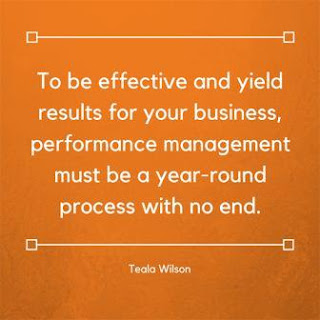Performance Appraisal Management System (PAMS)|Guidelines for developing a performance Management system
Performance Appraisal Management System (PAMS)| Guidelines for developing a Performance Management System
 |
| Image by: Teala Wilson |
Performance
Appraisal Management System has been around for more than a decade (100
years) now, yet no one is getting it right! Too often, the employees’ listens
as the managers lead the conversation. An effective PAMS works similar to a walkie-talkie.
An
Introduction to Performance Appraisal Management System
It is a process which contributes to the effective
management of talents (Individual and team) in order to achieve improved levels
of employee and organization performance and development. A performance
appraisal is:
One of the Managers utmost important
responsibilities
An on-going process, not a single event.
The finale of brief meetings between the manager and
employee during the entire performance period.
An impartial way to determine whether the employee
has met preset expectations and how well he/she has done.
A tool to clarify current expectations and set new ones,
and to explore new responsibilities for the employee.
Why Performance Appraisal Management System?
As we know, Talent
Management (TA) is a continuous process to achieve the strategic goals of
the organization. While TA is about
harnessing the skills and knowledge of the available talent, PAMS is a process
of monitoring, nurturing, measuring and evaluating performance against
strategic goals. It is pertinent to mention here if conducted well PAMS can do
wonders for the employers in following manners. Eventually, it acts as an
effective tool to motivate, reward,
engage and retain employee
- Communicate corporate goals
- Provides management with information for making decisions about staff
- Provides an impartial basis for raises, promotions, training, and other personnel actions
- Strengthens working relationships
- Improve overall productivity
- Provides documentation for inquiries, claims, or actions.
- Develops and improves rapport with employees
- Identifies and reward the best performers
- Identifies employees who need coaching or training
- Demonstrates fairness to employees and improves morale
 |
| Image by: www.workcompass.com |
Guidelines for developing a Performance Appraisal Management System
PAMS goes way further than just doing a yearly
review for an employee. It is about continuously working together with that
employee, recognizing his/her strengths and development areas and helping
him/her to become a more effective and productive worker. An HR Manager must
know how to develop & effectively implement PAMS in order to be in a
position to help everyone in the organization work to their full potential.
Initiate by
assessing the Performance Appraisal process that is currently in place. Analyze
the type of feedback the employees are getting through this process. Is there a
need to revise or make additions to the evaluation process? Or would it be
enough to build on what you already have, or is there a need to develop a new
system altogether?
Ascertain
organizational goals clearly. A PAMS
should be designed to help employees achieve organizational goals – so take a
good look at what these goals are. In this process of identifying goals, it
would make sense to freeze on your sales goals as well as the new
products/services that you would like to develop. Identify processes or
procedures that could be simplified or done more effectively. Share your
expectations for better communication between departments and staff members.
Communicate
the organization’s expectations to each employee clearly. Acknowledge their
performance. This will encourage them. You also need to share “areas for
improvement” and how to improve them. Point out specific goals which you would
like them to accomplish. Prioritize these so the employee is aware of what is
topmost on the list and the deadline for each goal. Then comes the task of
monitoring their performance through the year. If they appear to be struggling
to meet the performance goals, speak to them to understand what the problem is
and if they require support or coaching.
 |
| Free Image Gallery |
Evaluate
performance. During each periodic formal performance review, let employees
know how they are doing. Provide specific feedback on their performance. Let
them know where they stand. Let them also know where the superlative performance
will lead them to and the penalties of underperformance. Find out, if any
grievances or problems need to be addressed.
Typically in organizations, formal performance
reviews happen twice a year – Mid-Year review & Annual Review (year-end).however,
depending on the role and need of the job holder – informal reviews can be done
more often as an ongoing process.
People Managers checklist for Performance Appraisal Management System (PAMS)
- Ensure the employee has clearly defined goals and objectives
- Provide candid feedback on individual performance.
- Specify the period for the objectives to be achieved.
- Define the right attitude, knowledge and skills for effective individual performance
- Determine a training, education and development plan for the employee
- Undertake timely evaluation and fair assessment of employee’s performance
- Identify deficits through performance management, bring them to the attention of the employee, and address them through training and workplace support; and
- Document all interactions with the employee during performance review
Related Post: https://www.endtoendhrblog.com/
I will prefer this blog because it has much more informative stuff. Visit HR Consulting Companies for more related information and knowledge.
ReplyDelete